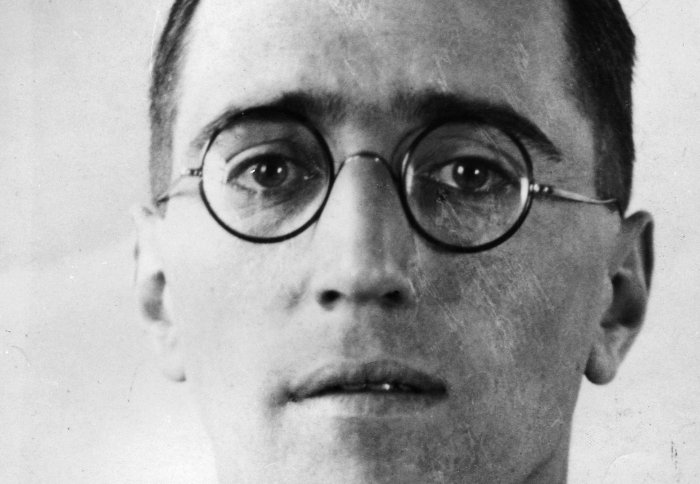A posthumous Grammy Award for the inventor of stereo sound
by Jane Horrell

Alan Blumlein (image: EMI)
One of our most distinguished alumni, Alan Dower Blumlein, is to be given a posthumous Grammy Award for technical services to music.
 Sunday night saw the annual Grammy Awards, but the artists and songwriters are not the only recording giants to be honoured for their contributions to the music industry.
Sunday night saw the annual Grammy Awards, but the artists and songwriters are not the only recording giants to be honoured for their contributions to the music industry.
Blumlein was one of the most prolific inventors of the 20th century, whose work transformed telecommunications, television and radar. Arguably the most notable of his many achievements is his invention of stereo recording, which has transformed the way we listen to sound.
Born in 1903, Blumlein grew up in London, graduating from Imperial College with a first class degree and beginning work at International Western Electric in 1924. While there, he performed important work on the reduction of cross-talk, and developed measuring equipment that helped establish standards for long-distance telephony.
In 1929, he joined the Columbia Gramophone Company, one of the forerunners of EMI, and invented a new form of disc cutting head that allowed simultaneous recording of two audio channels in a single record groove, which much improved sound quality. He also developed a series of ‘moving coil’ microphones that were used by the BBC and at EMI's recording studios.
The idea for stereo sound came to Blumlein while at the cinema, initially as a way to improve the audience experience by allowing the voice of an actor to follow their image on the screen rather than it being heard from a fixed single location. In 1931 he filed the patent for what he called his “binaural” two-channel recording and playback technique now known as stereo.
 This recording method, still used today and known as the ‘Blumlein pair’, features two dipole microphones (which can pick up sound from two directions – front and rear) arranged at right angles to each other. The two microphones combined can detect sound from any direction from which it originates, duplicating the way we hear sound from two separate ears.
This recording method, still used today and known as the ‘Blumlein pair’, features two dipole microphones (which can pick up sound from two directions – front and rear) arranged at right angles to each other. The two microphones combined can detect sound from any direction from which it originates, duplicating the way we hear sound from two separate ears.
Some of his first major stereo recordings were made of the London Philharmonic Orchestra with Sir Thomas Beecham in 1934, at what would be subsequently known as Abbey Road Studios. Surprisingly, mono recording remained the dominant format for some time: 30 years later, even The Beatles, innovators in sound recording in their own right, were using single-channel techniques at Abbey Road up until 1967.
Blumlein also recorded a number of short test films demonstrating the stereo principle, and spent the mid-1930s developing circuitry for electrical television and produced numerous related patents.
During World War II, while a senior engineer at EMI, he was seconded to the war effort. His binaural technique was used to develop the H2S airborne interception radar system, which allowed British planes to detect German aircraft at night. He was killed with ten passengers and crew when the Halifax bomber being used as a flying laboratory, caught fire and crashed in 1942, at the age of 38.
Given the highly secret nature of H2S, Blumlein's death was not announced officially for three years; and so despite this major contribution to the military, as well as his ground-breaking work in sound recording and television, his role in technological history was not widely known for some time.
Interest in stereo sound grew in the 1950s, and in 1958 he was honoured posthumously by the Audio Engineering Society. His achievements are also commemorated by the Institute of Electronic and Electrical Engineers with an IEEE Milestone plaque at Abbey Road.
Blumlein’s revolutionary contributions to sound recording will be recognised by the Recording Academy with a special award, to be presented to his family in a ceremony in Los Angeles in June this year.
His son, Simon Blumlein, commented, “It is a great honour for my father and the Blumlein family to be recognised with such a prestigious award. We’re so immensely proud of him and how his work transformed sound recording. He’s always been held in the highest esteem by recording engineers and so to now receive this acknowledgement from the wider music industry is simply wonderful.”
Like Alan Turing, another exceptional genius inventor engaged in top-secret war work, a film featuring Alan Blumlein’s life and work is reportedly in development by Universal Music Group, which merged with EMI in 2012.
Sir Lucian Grainge, chairman and CEO of Universal Music Group, said, “Alan Dower Blumlein and his prolific period of invention whilst at EMI, not only transformed audio and music recording technology, but also helped shape modern media communications for generations to come through his pioneering work in television. We are delighted that the Recording Academy has chosen to honour his legacy with this posthumous Grammy award. His work, productivity and lasting scientific impact continue to entertain, educate and inspire millions today.”
Article text (excluding photos or graphics) © Imperial College London.
Photos and graphics subject to third party copyright used with permission or © Imperial College London.
Reporter
Jane Horrell
Department of Electrical and Electronic Engineering